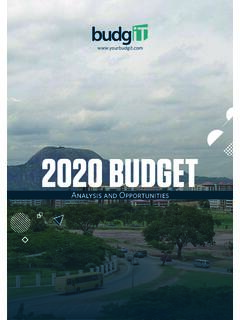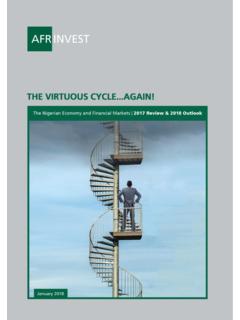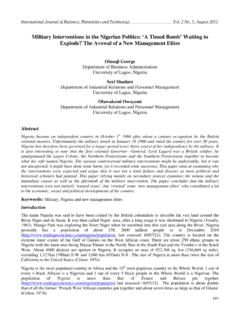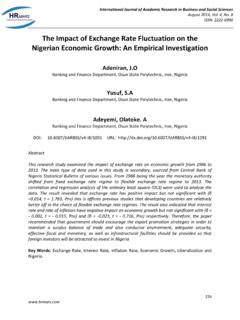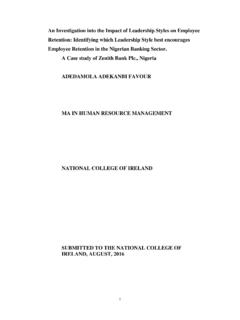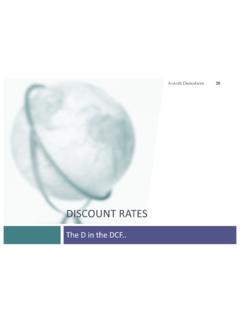Transcription of Environmental impact assessment in ... - Nigerian Law Guru
1 63 Environmental impact assessmentin Nigeria: regulatory background andprocedural frameworkNerry Echefu and .E AkpofureABSTRACTAs a consequence of the illegal dumping of toxic wastes in Koko, in theformer Bendel State, in 1987, the Nigerian Government promulgated theHarmful Wastes Decree which provides the legal framework for theeffective control of the disposal of toxic and hazardous waste into anyenvironment within the confines of Nigeria. This was immediately followedby the creation of a regulatory body, the Federal Environmental ProtectionAgency (FEPA) in 1988. FEPA is charged with the overall responsibility ofprotecting and developing the Nigerian environment. To put this into actiona National Policy on the Environment was developed. This is the mainworking document for the preservation and protection of the Nigerianenvironment.
2 States and Local Government Councils were also encouragedto establish their own Environmental regulatory bodies for the purpose ofmaintaining good Environmental quality as it applies to their EIA Decree No. 86 of 1992 is an additional document with the same aimof protecting the Nigerian environment. It is particularly directed atregulating the industrialization process with due regard to the this Decree, no industrial plan/development/activity falling under theFEPA s mandatory list can be executed without prior consideration of theenvironmental consequences of such a proposed action, in the form of anenvironmental impact Department of Petroleum Resources (DPR), an arm of the Ministry ofPetroleum Resources, recognizing the national importance of the oil and gasindustry sector to the continued growth of the Nigerian economy andrealizing that the continued exploitation, exploration and production of theoil resources has serious Environmental impacts, also decided to set outcomprehensive standards and guidelines to direct the execution of projectswith proper consideration for the environment.
3 The DPR EnvironmentalGuidelines and Standards (EGAS) of 1991 for the petroleum industry is acomprehensive working document with serious consideration for thepreservation and protection of the Niger Delta, and thus the NigerianCase Study 7 See Topic 2 UNEP EIA TrainingResource ManualLaw, policy andinstitutional arrangementsUNEP EIA Training Resource Manual Case studies from developing countries64environment, in the course of searching for and producing crude oil. TheEIA tool is also mandatory for a greater part of the oil E&P a detailed examination of the various statutes, and the framework forthe EIA process in particular, and the entire Environmental regulatoryprocess in general, reveals that many of the statutes are very much atvariance with intentions, especially as they affect the execution of is duplication of functions and overlapping responsibilities in theprocesses and procedures guiding the execution of the various impactassessment tasks.
4 Consequently, serious bottlenecks and bureaucraticconfusion are created in the process. The result is a waste of resources,financially and paper examines the statutory regulatory framework for the EIAprocess, and the inadequacies and misinterpretations of the various statutes,which have often led to delays in the execution of EIAs in Nigeria. Anattempt will be made to streamline these various responsibilities through areorganization of the regulatory Environmental framework. This way, it ishoped that the bottlenecks and wastage of resources will be (Africa s most populous nation), independent since 1960, occupiesan area of 923,768 km2 with varied climates and seasons. Presently, itsestimated population is over 100 million to oil, agriculture (before 1970) was the economic mainstay.
5 Withfinancial resources available from oil and no development policy, unguidedurbanization and industrialization took place. Uncontrolled populationgrowth, desertification, and deforestation led to degradation anddevastation of the desirable and necessary as development is, it became an albatross not ofitself but because of the lack of appropriate policies to guide were several sectoral regulations aimed at controlling environmentaldegradation which were unsuccessful due to the absence of effectivesanctions. Economic considerations and fundamental lack of knowledge ofinterdependent linkages among development processes and environmentalfactors, as well as human and natural resources, resulted in an unmitigatedassault on the environment. However, the environment and the need for itspreservation (in spite of all efforts by United Nations Environment Program[UNEP] and International Conventions which Nigeria ratified), took centrestage after the momentous and singular event of the secret dumping of toxicwaste in Koko Port, Bendel State (now Delta State) in May 1988 by foreignparties.
6 This was followed by the promulgation of the Harmful Wastes(Special Criminal Provisions) Act 1990. In its wake, international seminarsand workshops were held in Abuja and Lagos and the consensus was forUNEP EIA Training Resource Manual Case studies from developing countries65appropriate Environmental legislation to discourage short-term plans and fire brigade approaches to Environmental institutional framework was set up to deal with the problems of ourenvironment. The Federal Environmental Protection Agency (FEPA),established by Decree 58 of 1988 of the same name and amended by Decree59 of 1992, was given responsibility for control over our environment andfor the development of processes and policies to achieve this. Apart frompublishing the National Policy on the Environment (NPE) in 1989, with thepolicy goal of achieving sustainable development, it published other sectoralregulations including the National Environmental Protection (PollutionAbatement in Industries and Facilities Generating Wastes) Regulation 1991wherein EIA was made obligatory only when so demanded by FEPA andcompliance was within 90 days of such demand.
7 However in the oil industrythe principal legislation is the Petroleum Act 1969 and all derivativeregulations charged DPR among others with pollution and Local Government Councils (LG) which comprise the second andthird tiers of government were encouraged under Decree 59 of 1992 to set uptheir own Environmental protection EIA legislation, the EIA Decree 86 of 1992, was promulgatedestablishing FEPA as the apex regulator, making EIA mandatory for alldevelopmental purposes (although with some exceptions). Under it FEPAhas published various sectoral EIA procedures together with EIA proceduralguidelines in AND REGULATORY FRAMEWORKP rior to the establishment of the FEPA there were sectoral environmentalregulations with various significant responsibilities relating toenvironmental protection and improvement.
8 Also in existence werecommissions with advisory capacity in Environmental matters andenvironmental to various activities and the complex combination of interdependentoperations of the oil industry it, more than any other sector, adverselyaffects the the oil industry DPR adopted remedial, though inadequate, enforcementtools which included compliance monitoring and the issuing ofpermits/licences. Studies indicated the extent of devastation the oil industryhas caused to aquatic and terrestrial ecosystems and cultural and historicalresources. This, coupled with the community s dissatisfaction and agitation,especially in the Ogoni and Ijaw homelands, reinforced the need for thesector to plan, protect and enhance prudently the Environmental resourcesfor a better EIA Training Resource Manual Case studies from developing countries66 The need to control new installations or projects with capacity to degradethe environment was also identified.
9 This compelled DPR to issue updatedEnvironmental Guidelines and Standards (EGAS) in 1991 providing for thefirst time, together with pollution abatement technology, guidelines andstandards and monitoring procedures, a mandatory EIA report asenforcement tool. There are other regulatory bodies within the , charged with the protection and development of the environment,prepared a comprehensive national policy, including procedures forenvironmental impact assessment for, amongst others, all developmentprojects. Enforcement powers were also prescribed. In the National Policyon the Environment (NPE), FEPA adopted a strategy that guarantees anintegrated holistic and systemic view of Environmental issues that leads toprior Environmental assessment of proposed other regulators including State EPAs (unnecessarily charged withsimilar and identical responsibilities to those of FEPA) rather thancooperating with FEDA undermine its efforts as they demand a role in thestate of the environment within their areas.
10 This occurs particularly whereFEPA involves them only at the review stage in the EIA process. This createsa lot of confusion and bureaucratic delays in implementing the EIA processleading to enormous cost and unnecessary waste of impact assessment SYSTEMF eaturesThe principal legislation is Decree 86 of 1992 which made EIA mandatoryfor both public and private sectors for all development projects. It has threegoals and thirteen principles for how these are to be achieved. The goals are: Before any person or authority takes a decision to undertake orauthorize the undertaking of any activity that may likely orsignificantly affect the environment, prior consideration of itsenvironmental effects should first be taken. To promote the implementation of appropriate procedures to realizethe above goal.



